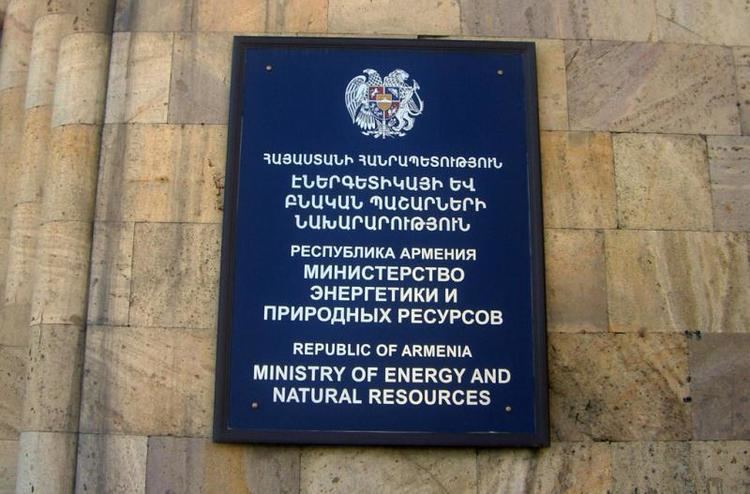Jurisdiction Government of Armenia Website www.minenergy.am | Headquarters Yerevan | |
 | ||
Formed 1992 as Ministry of Energy and Fuel of the Republic of Armenia Minister responsible Ashot Manukyan, Minister of Energy Infrastructures and Natural Resources | ||
The Ministry of Energy Infrastructures and Natural Resources of The Republic of Armenia (Armenian: ՀՀ Էներգետիկ ենթակառուցվածքների և բնական պաշարների նախարարություն) is the ministry responsible for the management of the energy systems, and control of the exploitation of natural resources in Armenia. It elaborates and implements the policies of the Republic of Armenia Government in the energy sector.
Contents
- History
- Structure
- Energy security
- Strategic plans
- Construction of new generating capacities
- Regional integration
- Investment Projects
- References
Its history can be traced to the time that Armenia was still in the Soviet Union. Since that time, many ministers have changed, as well the official name of the ministry, while maintaining the the word 'energy' in its name. As of 2016, it is one of the 18 ministries in Armenia, and plays an important role in regulating the laws and policies regarding the energy and natural resource spheres.
History
The Armenian energy system has a 100-year history, during which time the ArmEnergo department played an important role. ArmEnergo was formed in November 1936 with the decision of the Soviet Union with the aim of managing and controling the exploitation and development of electric stations and networks. The two hydropower plants of Yerevan, the Gyumri HPP, Dzora HPP and other technical services were part of ArmEnergo. Later on ArmEnergo became the official body eligible to control the whole energy system of Armenia.
After the collapse of the Soviet Union, Armenian economic reforms, and dawn of an energy crisis required new control mechanisms. In order to overcome this, in 1992 the Ministry of Energy and Fuel of the Republic of Armenia was created. The ministry was renamed as the Ministry of Energy of The Republic of Armenia on August 4, 1995 by a decision of the Armenian government. Once more, the ministry was renamed as Ministry of Energy and Natural Resources of The Republic of Armenia by a decree of the Armenian president on 18 April 2008, which was renamed as the Ministry of Energy Infrastructures and Natural Resources of The Republic of Armenia on September 30, 2016. Today, the main aim of the ministry is to develop and maintain the governance policy of the Republic of Armenia in the sphere of energy infrastructures and natural resources.
Structure
Ashot Manukyan is the current Minister, and the the Deputy Ministers are Areg Galstyan, Iosif Isayan, Hayk Harutyunyan, and Vardan Gevorgyan.
The structure of the ministry is as follows:
Energy security
The concept of Energy security of The Republic of Armenia is aimed at ensuring the energy security of the Republic of Armenia in conformity with the provisions of the National Security Strategy of the Republic of Armenia. Energy security is a system of political, economic, legal, organizational, methodological, and other activities that provide affordable prices to meet the daily needs of high-quality and reliable power supply, as well as in emergency situations, and during war.
Armenia has adopted a sustainable development policy which implies the development of the energy sector as the most important area. This sector's aim is to ensure the kind of progress that will create preconditions for the harmonization and balance of environmental issues for sustainable development of the next generation, while reducing energy loss. Because of Armenia's limited hydrocarbon resources, energy security has become imperative for the presence of energy resources, including the balance of renewable energy sources (renewable energy), and the extensive use of full inclusion.
Since there are no fossil fuel resources in Armenia, the function of Ministry of Energy Infrastructures and Natural Resources of The Republic of Armenia and natural in the framework of the energy security's concept is to increase energy efficiency in the economy, develop nuclear energy, and efficiently use renewable energy resources.
The adoption of the concept of energy security is due to:
- The regional and the world's political and socio-economic rapid development, global economic crisis, as well as Armenia's energy independence, security of emergency, and war.
- Proper engagement of Armenia in regional programs that are implemented in the region by the European Union, Russia, the United States and other international organizations.
- The importance of creating a long-term strategic reserve of fuel and energy resources.
Strategic plans
Strategic plans of the ministry are based on a three-level diversification policy:
- Generation of energy (HPPs, NPPs, TPPs, and other power plants)
- Energy supply (fuel supply), such as natural gas, oil and other fuels
- Fuel and energy transportation: natural gas delivery by pipelines, oil product delivery and other related transportation
The three-level diversification policy's aim is to provide a sufficient level of energy security, to have electricity and gas consumption reserves in both emergency and force majeure situations. In the framework of this policy there are programs to neutralize internal and external threats, for life-time extension of the Armenian Nuclear Power Plant, and for construction of new cost-effective electricity generating facilities.
Construction of new generating capacities
Regional integration
Investment Projects
The Ministry of Energy Infrastructures and Natural Resources of Armenia has continuous goals to contribute to the development of the energy sector in the Republic of Armenia. Thus, every year, it starts to accomplish new projects in the field of renewable energy in conjunction with various international companies and investors.
